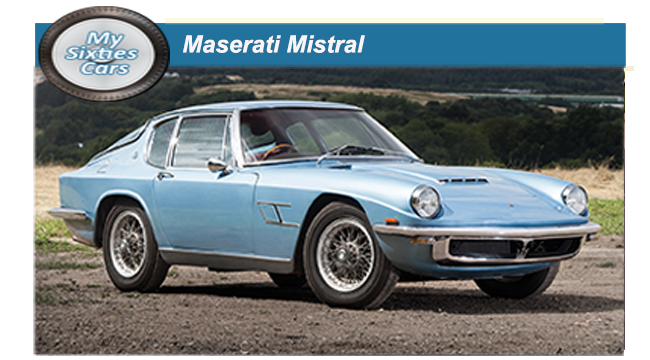 Styling changed considerably for the next Maserati model, designed by Pietro Frua as a sporty follow-up to the Sebring.
Styling changed considerably for the next Maserati model, designed by Pietro Frua as a sporty follow-up to the Sebring.
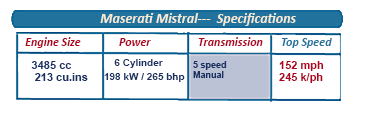 by Colonel Simone, the principal Maserati importer in France,the Mistral referred to the cold northerly wind that blows from the south of France, emanating all the way from the Rhône valley.
The Mistral proved comparably hot when hitting the gas pedal hard.
by Colonel Simone, the principal Maserati importer in France,the Mistral referred to the cold northerly wind that blows from the south of France, emanating all the way from the Rhône valley.
The Mistral proved comparably hot when hitting the gas pedal hard.
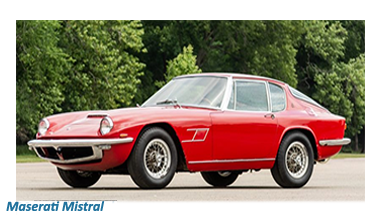 For the first time, Maserati called upon talented freelance designer Pietro Frua to design the Mistral.
Frua had succeeded in capturing the attention of Giulio Alfieri Maserati’s head of development as a result of his cooeration with AC Motors in the UK. Developing the Mistral was the first of many assignments Frua would undertake with Maserati.
The new Mistral was regarded as a design masterpiece, with the Mistral Coupé outstanding for its innovative glass ‘hatchback’ boot.
Early examples of the Maserati Mistral were equipped with the same 3.5-litre six-cylinder engines that powered the 3500GT series and the Sebring,
For the first time, Maserati called upon talented freelance designer Pietro Frua to design the Mistral.
Frua had succeeded in capturing the attention of Giulio Alfieri Maserati’s head of development as a result of his cooeration with AC Motors in the UK. Developing the Mistral was the first of many assignments Frua would undertake with Maserati.
The new Mistral was regarded as a design masterpiece, with the Mistral Coupé outstanding for its innovative glass ‘hatchback’ boot.
Early examples of the Maserati Mistral were equipped with the same 3.5-litre six-cylinder engines that powered the 3500GT series and the Sebring,
![]()
That power plant was replaced after 1964 by 3964-cc and 4014-cc versions, as in the Sebring.
The Mistra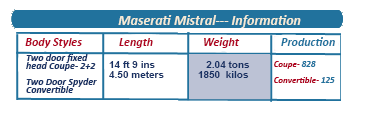 l was fitted with a five-speed manual transmission as standard although for those who preferred it a three-speed automatic transmission was available.
l was fitted with a five-speed manual transmission as standard although for those who preferred it a three-speed automatic transmission was available.
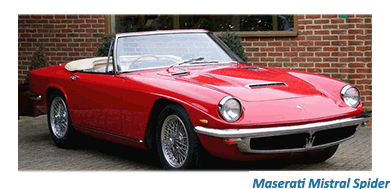 Although shorter in wheelbase than the Sebring at 94.5 inches, the Mistral was similar in overall length, meaning that both versions of the Mistral stood out for their well-rounded profiles.
Although shorter in wheelbase than the Sebring at 94.5 inches, the Mistral was similar in overall length, meaning that both versions of the Mistral stood out for their well-rounded profiles.
Maserati script and the trident insignia were evident on the back panel, alongside the license plate, with other key design features including h a lower beltline and curved glass, a long, sloping hood with small air scoop rounded off by a slim wraparound front bumper above the grille.
The Mistral was the last production Maserati to use their famous straight six-cylinder, twin-spark, double overhead cam engine, the same engine that had powered one of the world's most iconic Formula 1 cars, Maserati's 250F, which won eight races and the F1 championship for Juan Manuel Fangio in 1957.
![]()
A rare and delicate machine, the Mistral carries significant historical relevance today.
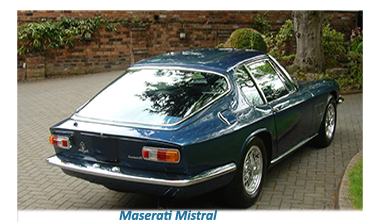 In 1968 a Mistral Spyder became the most modern car ever to win the Best in Show award at the Pebble Beach Concours elegance.
In its seven-year production run, Maserati produced only 125 Mistral Spyders.
As a result of its rare good looks and scarcity, the Maserati Mistral was much sought after collectors item of the wealthy and famous.
Among the Mistral's high profile owners were British superstar of the Sixties, Laurence Harvey as well as two “local heroes” of the big screen, Ugo Tognazzi and
Alberto Sordi.
In 1968 a Mistral Spyder became the most modern car ever to win the Best in Show award at the Pebble Beach Concours elegance.
In its seven-year production run, Maserati produced only 125 Mistral Spyders.
As a result of its rare good looks and scarcity, the Maserati Mistral was much sought after collectors item of the wealthy and famous.
Among the Mistral's high profile owners were British superstar of the Sixties, Laurence Harvey as well as two “local heroes” of the big screen, Ugo Tognazzi and
Alberto Sordi.






